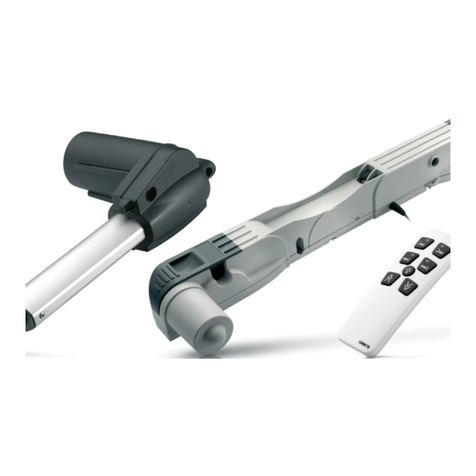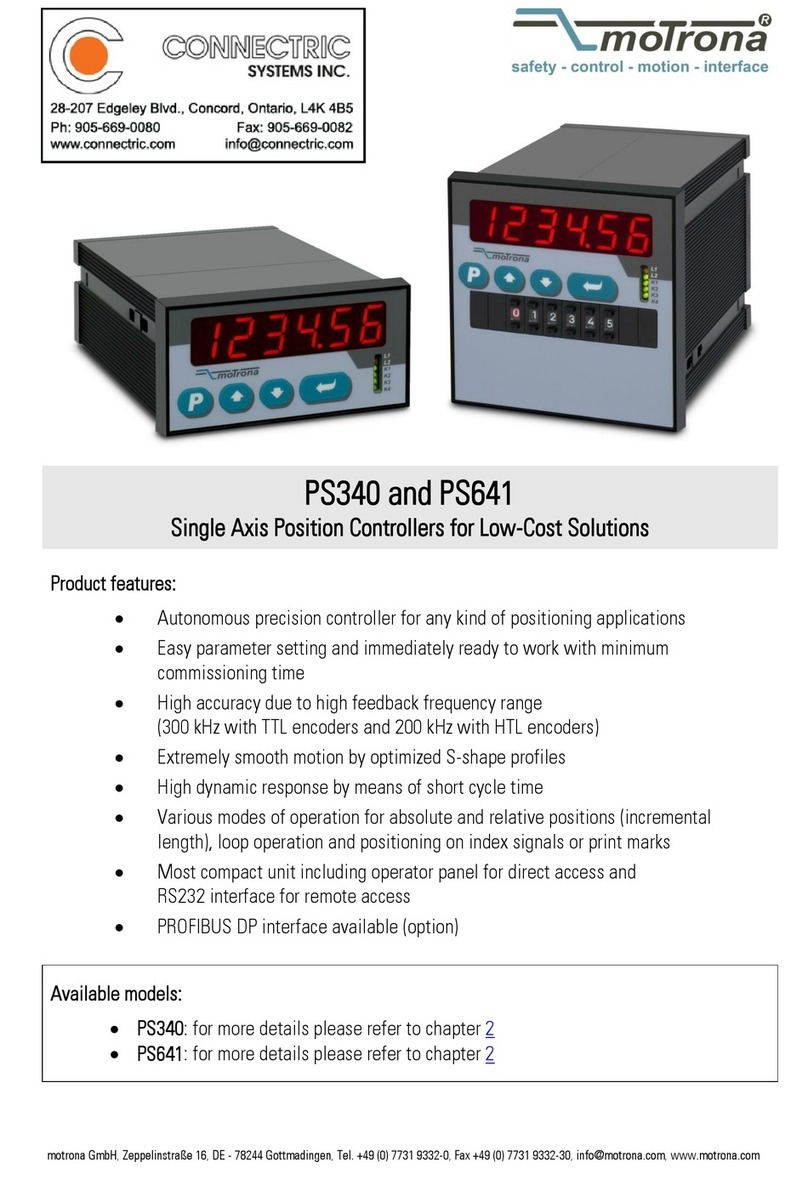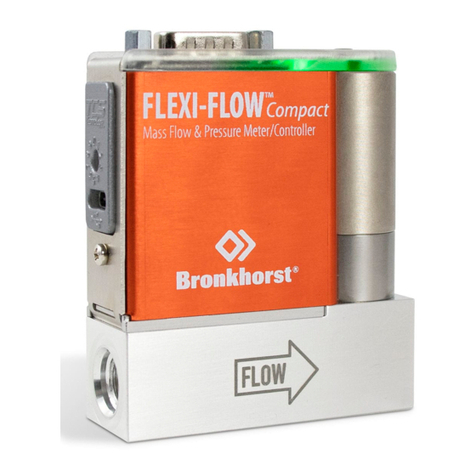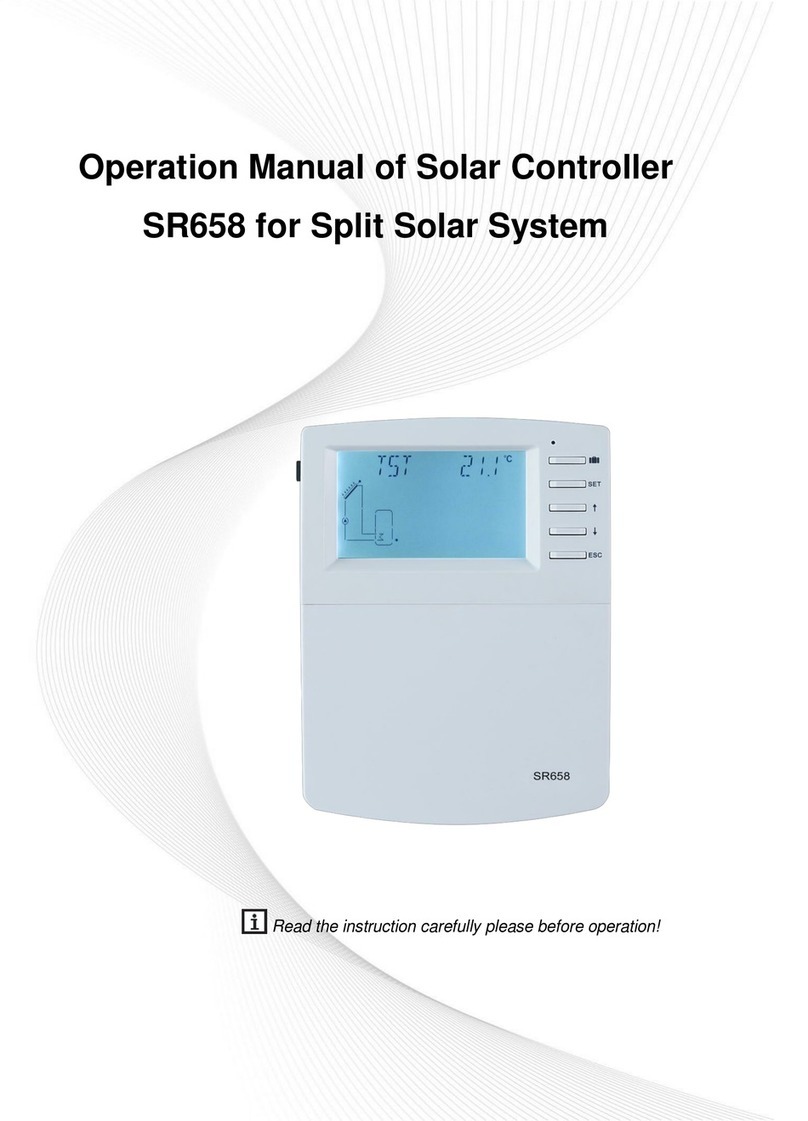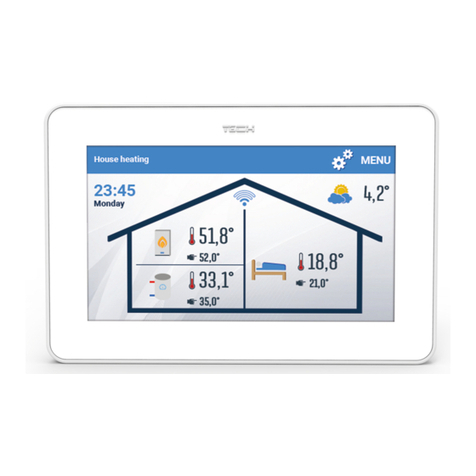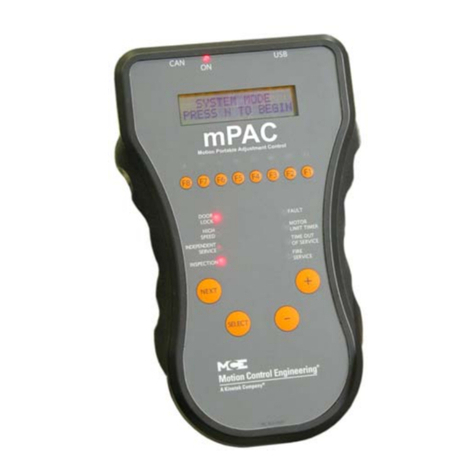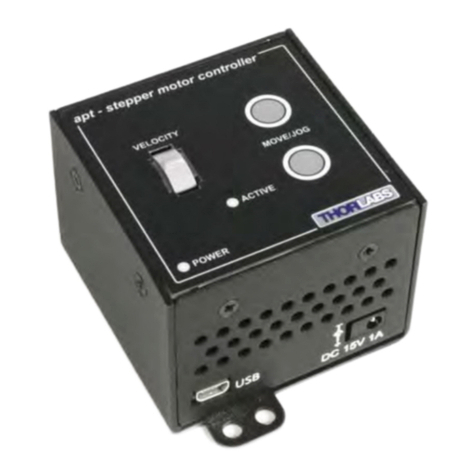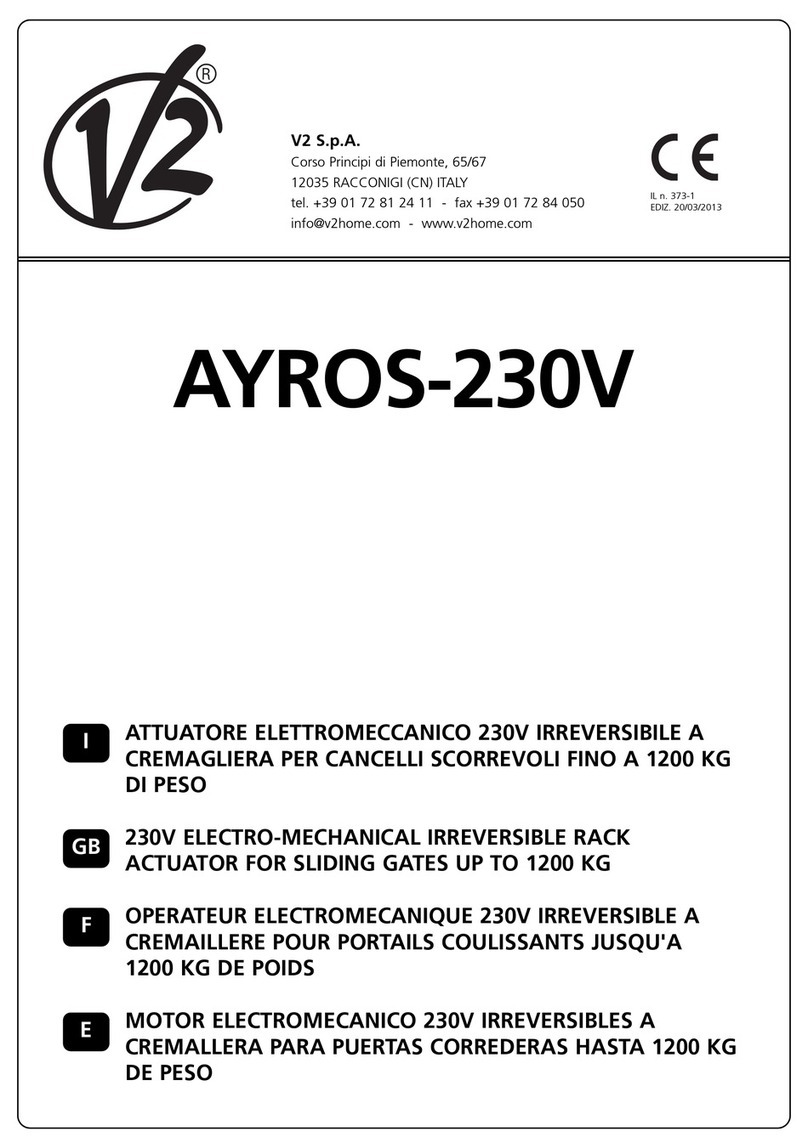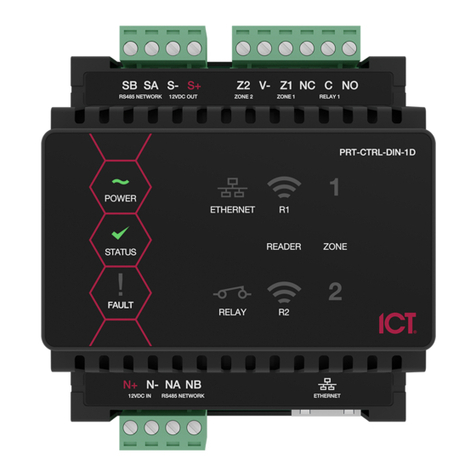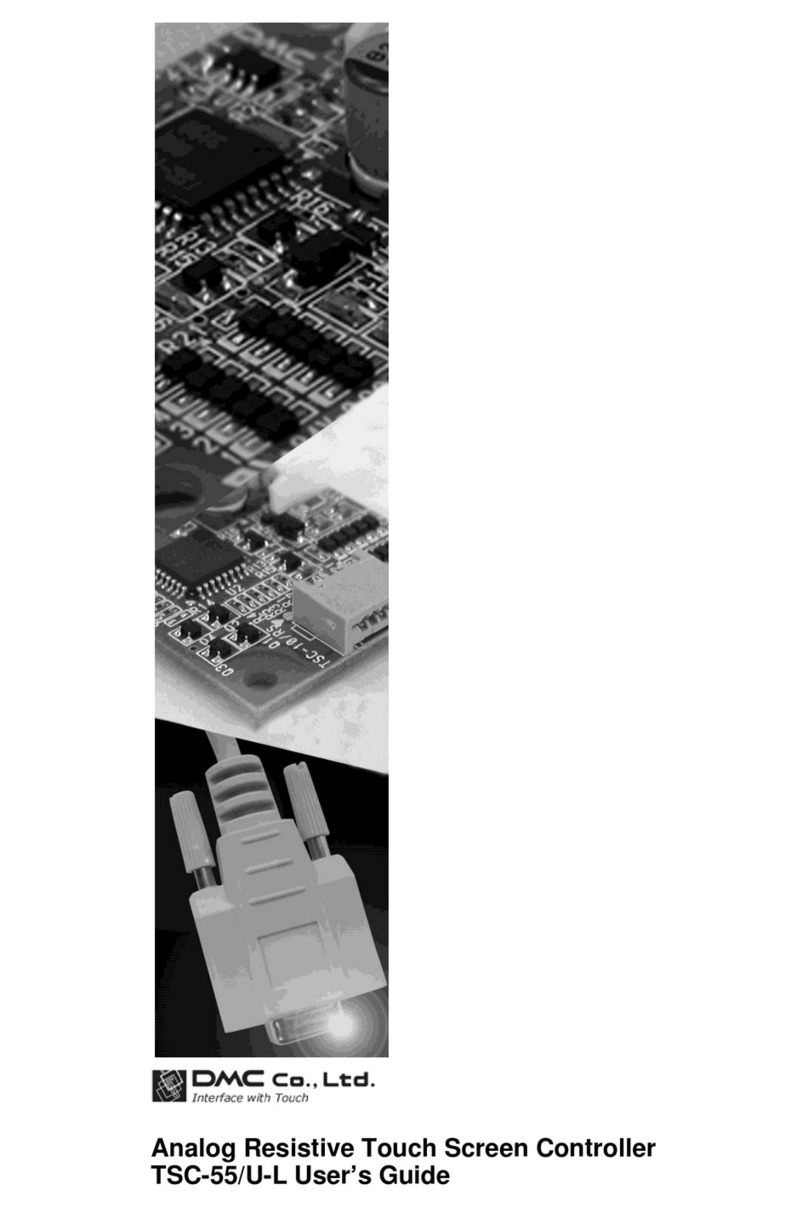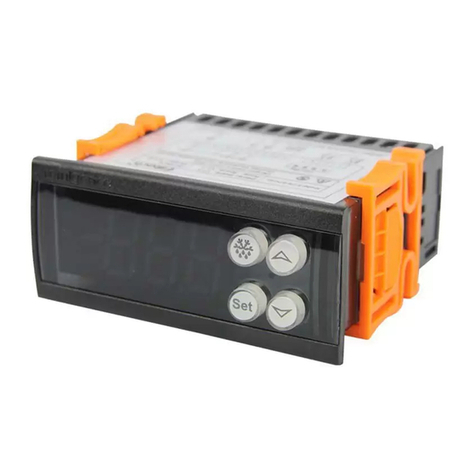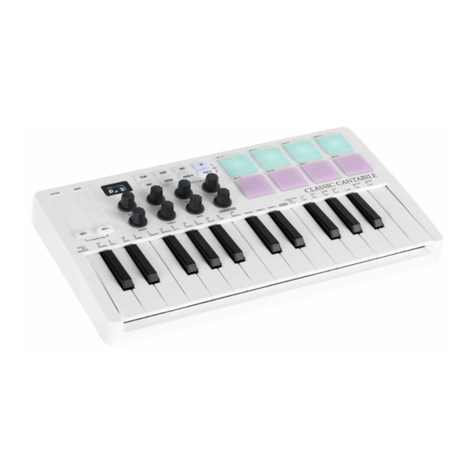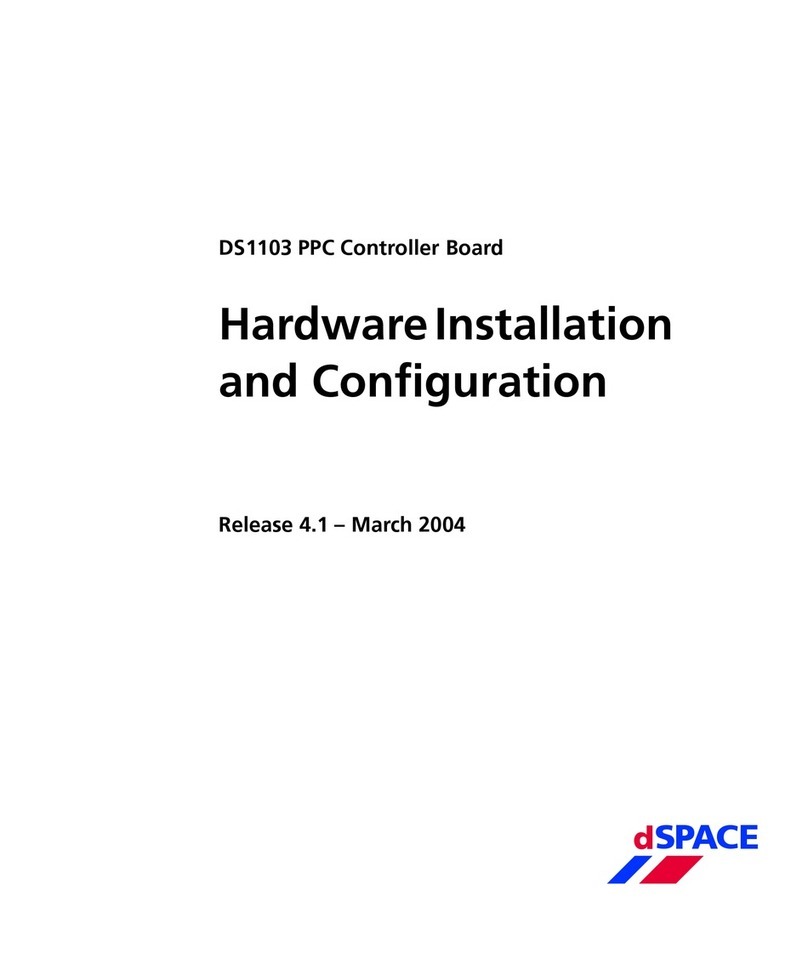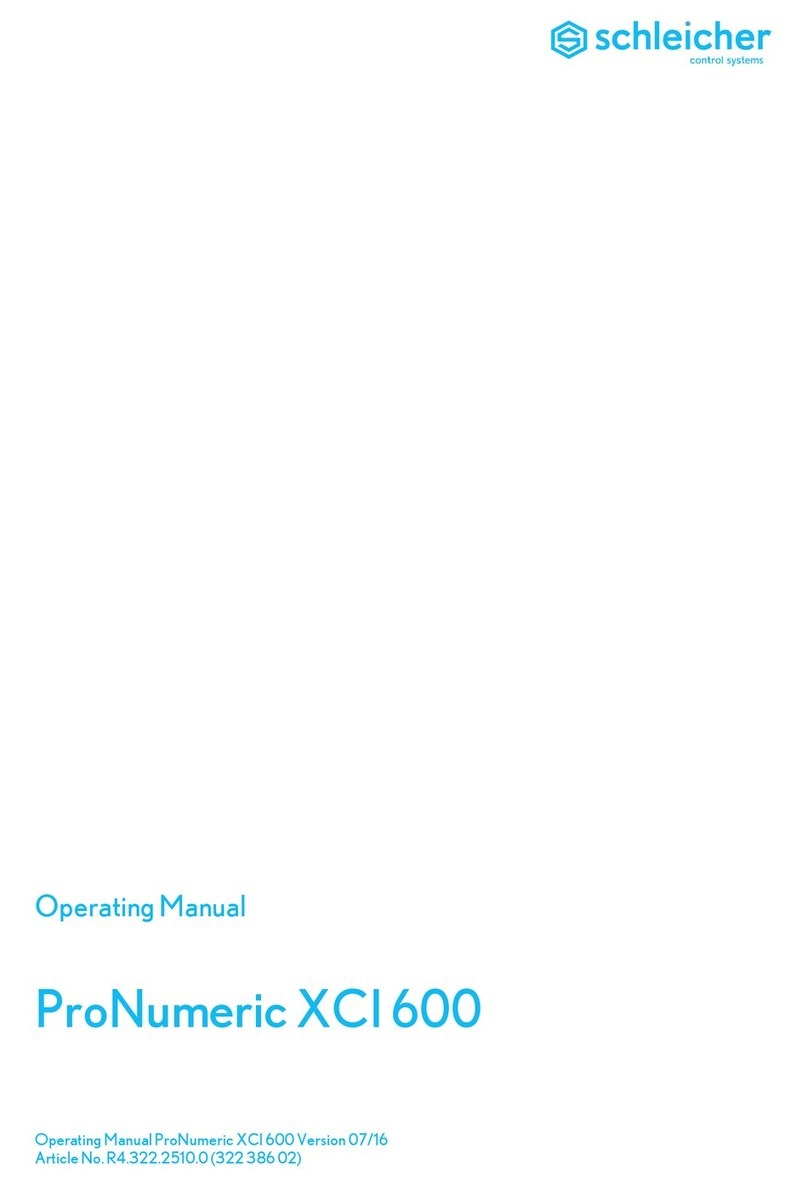TERMOFOL TF-H1 Mark II User manual

TERMOREGULATOR
TERMOFOL TF-H1 Mark II
INSTRUKCJA OBSŁUGI
I KONFIGURACJI TERMOREGULATORA
Instrukcja montażu
Installation manual

CHARAKTERYSTYKA I DANE TECHNICZNE
Dziękujemy za zakup naszego produktu. Liczymy, że będziecie Państwo zadowoleni
z korzystania z termoregulatora TERMOFOL TF-H1 Mark II. Jest to w pełni funkcjo-
nalny sterownik instalacji i urządzeń grzewczych, zapewniający najwyższy komfort
obsługi oraz precyzyjne i użyteczne funkcje, które pozwolą Państwu w pełni uzyskać
kontrolę nad klimatem pomieszczeń. Poniżej przedstawiono wyświetlacz termore-
gulatora oraz jego podstawowe parametry techniczne.
Rys. 1
Specykacja techniczna:
• Pobór mocy < 2 W
• Napięcie zasilające: 230 V AC 50/60 Hz
• Maksymalne natężenie przełączanego prądu: 16A
• Zakres programowanej temp.: 1÷70 °C
• Fabryczny zakres programowanej temp.: 5÷35 °C
• Wewnętrzny czujnik temp. powietrza
• Dokładność: ±0.5 °C
• Stopień ochrony IP20
• Zewnętrzny czujnik temp. podłogi: NTC
Charakterystyka:
• Sterowanie manualne
• Możliwość programowania
• Sposób montażu: natynkowy w puszce elektrycznej
• Kolor: Biały/Czarny
• Wymiary zewnętrzne: 86 mm x 86 mm x 27 mm
• Gwarancja: 24 miesiące
• Zewnętrzny czujnik podłogowy w zestawie

INSTALACJA TERMOSTATU, POŁĄCZENIA ELEKTRYCZNE
Rys. 2 12 3 4
1. Zacisk podłączenia przewodu fazowego zasilania sterowanego odbiornika (maty, folii grzewczej)
2. Zacisk podłączenia przewodu neutralnego zasilania sterowanego odbiornika (maty, folii grzewczej)
3. Zacisk podłączenia przewodu neutralnego zasilania termoregulatora
4. Zacisk podłączenia przewodu fazowego zasilania termoregulatora
5,6. Zaciski podłączenia zewnętrznego czujnika temp. NTC (biegunowość nie ma znaczenia)
5
6
TERMOFOL TF-H1 Mark II to nowoczesny, wyposażony w panel sterujący LED, pro-
gramowalny termoregulator przeznaczony do sterowania elektrycznymi systemami
grzewczymi. Termoregulator odczytuje temperaturę z wewnętrznego i zewnętrzne-
go czujnika temperatury, który jest dołączony w zestawie. Przed montażem, demon-
tażem, czyszczeniem, dokonywaniem przeglądu, zawsze odłącz termoregulator od
źródła zasilania, np. wyłączając linię zasilającą w rozdzielni elektrycznej.
Zapoznaj się z całą treścią niniejszej instrukcji przed rozpoczęciem instalacji termo-
regulatora. Na terenie RP, połączeń elektrycznych termoregulatora musi dokonać
elektryk posiadający czynne uprawnienia SEP do robót elektroinstalacyjnych do 1
kV. Instalacja elektryczna zasilająca termoregulator powinna odpowiadać wymo-
gom określonym w Rozporządzeniu Ministra Infrastruktury i Budownictwa w spra-
wie warunków technicznych jakim powinny odpowiadać budynki i ich usytuowanie
[DZ.U. z 7 czerwca 2019, poz. 1065] wraz z normami odniesienia.
TERMOFOL TF-H1
MARK II
IP21

sensor
1,2m
Przykład umiejscowienia termoregulatora
Rys. 3
Termoregulator może być instalowa-
ny w standardowej puszcze ścien-
nej 86mm lub europejskiej okrągłej
60mm.
1. Podłącz zasilanie oraz pozostałe
przewody zgodnie ze schematem
podłączenia.
1
2
34
2. Przykręć blachę montażową
do puszki montażowej.
3. Podłącz ekran LCD z blachą
montażową.
4. Gotowe.
Rys. 4
Rys. 5
Rys. 6

Przykład właściwego podłączenia termoregulatora
Rys. 7
W celu instalacji termoregulatora w puszce elektrycznej i podłączeń elektrycznych
należy bardzo delikatnie (tak by nie urwać taśmy połączeniowej) otworzyć obudo-
wę, zdejmując zespół wyświetlacza zgodnie z instrukcją przedstawioną na rysunku
4. Ekran należy delikatnie przesunąć w górę. (odwrotnie niż przedstawia to rys.6)
Instalacja termoregulatora powinna być zaplanowana w miejscu nienarażonym na
kontakt z promieniami słonecznymi. Rysunek nr 2. przedstawia listwę zaciskową
termoregulatora służącą do wykonania podłączeń elektrycznych urządzenia z siecią
elektryczną. Przewody należy podłączyć według podanego schematu. Po zakończe-
niu instalacji i wykonaniu połączeń elektrycznych należy dokonać konguracji syste-
mu zgodnie z kolejnym punktem niniejszej instrukcji.
STEROWANIE – OPIS FUNKCJI PRZYCISKÓW STERUJĄCYCH
Poniżej przedstawiono identykację graczną przycisków panelu sterującego (wy-
świetlacza) termoregulatora. Przyciski te są multi-funkcjonalne, tzn. w zależności od
stanu pracy termoregulatora, oraz różnicując czas utrzymywania dotyku możliwe
jest wydawanie różnych komend termoregulatorowi. Poniżej dokonano deskrypcji
przycisków oraz szczegółowo omówiono dostępne z ich udziałem funkcje termore-
gulatora.
Przycisk włącz/wyłącz
W stanie wyłączonego termoregulatora dotknięcie tego przycisku przez 3–5
sekund pozwala kongurować ustawienia zaawansowane A.
W stanie włączonego termoregulatora jego dotknięcie uaktywnia tryb manualny lub
programowalny.

W stanie włączonego termoregulatora dotknięcie przycisku przez 3–5 sekund
pozwala użytkownikowi zaprogramować harmonogram pracy termoregulatora.
W stanie włączonego termoregulatora krótkie naciśnięcie daje możliwość ustawie-
nia godziny i dnia tygodnia. Natomiast dotknięcie przez 3-5 sekund pozwala akty-
wować tryb wakacyjny. Wciśnięcie w pozycji ON uaktywnia ten tryb. Następnie
klikając przechodzimy do ustawienia ilości dni w tym trybie. Kolejne naciśnięcie
pozwala ustawić temperaturę utrzymywaną w powyższym trybie.
W stanie wyłączonego termoregulatora dotknięcie tego przycisku przez 3–5
sekund pozwala kongurować ustawienia zaawansowane B.
Przycisk kursora zmniejszającego. W stanie załączonego termoregulatora
dotknięcie i przytrzymanie przez ponad 3 sek. załącza i wyłącza blokadę
przycisków tzw. „child lock”. Wielokrotne dotknięcia zmniejszają wartość
temperatury zadanej.
Przycisk kursora zwiększającego. W stanie załączonego termoregulatora do-
tknięcie i przytrzymanie przez ponad 3 sek. umożliwia odczyt temperatury
mierzonej przez zewnętrzny czujnik temperatury NTC (tylko jeśli w ustawie-
niach zaawansowanych B, parametr BN ustawiony jest na N3). Wielokrotne
dotknięcia zwiększają wartość temperatury zadanej.
W przypadku pracy termoregulatora w trybie automatycznego harmonogramu,
przyciski umożliwiają czasową korektę temperatury dla wykonywanego przez
termostat aktualnego okresu automatycznego harmonogramu.
godzina
tydzień
ustawiona temp.
temp. powietrza
tryb włączonego
ogrzewania
blokada
tryb wakacyjny
6 okresów
programowalnych
czujnik
podłogowy
wybrany program
tygodniowy
tryb automatyczny
tryb manualny

IKONY WYŚWIETLACZA – SPECYFIKACJA
ikona potwierdzająca pracę ter-
mostatu w trybie automatycznego
harmonogramu
AUTO
AUTO
tymczasowy tryb manualny
tryb manualny
tryb wakacyjny
wyłączenie ogrzewania, spo-
wodowane wysoką tempera-
turą podłogi
CLOCK
zegar
NTC zewn. czujnik temperatury
blokada przycisków
USTAWIENIE HARMONOGRAMU PRACY
W stanie włączonego termoregulatora naciśnij przycisk przez 3–5 sek. Przycisk
pozwala przejść do następnej pozycji. Wartości zmieniaj strzałkami. Istnieje
możliwość ustawienia temperatury dla 6 okresów. Fabrycznie wybrany tryb harmo-
nogramu to 5+2.
Poniższa tabela przedstawia fabryczny cykl dnia.
Programowanie okresów grzewczych w ciągu doby:
Naciśnij przez 3–5 sek. --> ustaw strzałkami godzinę rozpoczęcia pierwszego
okresu --> naciśnij --> ustaw temperaturę dla pierwszego okresu. Powtórz czyn-
ność dla wszystkich okresów grzewczych P1–P6, następnie powtórz schemat dla dni
weekendowych przechodząc przez punkty 6,7.
Pobudka Wyjście
z domu
Powrót
do domu
Wyjście
z domu
Powrót
do domu Sen
06:00 20 °C 08:00 15 °C 11:30 15 °C 13:30 15 °C 17:00 15 °C 22:00 15 °C
USTAWIENIA ZAAWANSOWANE A
Podczas wyłączonego termoregulatora naciśnij przycisk przez 3–5 sek. Aby przyjść do
kolejnego parametru naciśnij . Aby zmienić wartości używaj strzałek. Wartości zapisu-
ją się automatycznie. Po ustawieniu wymaganych wartości włącz termoregulator.

Nr Rodzaj parametru Zakres wartości
parametru Wartość
fabryczna
A1 Kalibracja czujnika
temperatury powietrza –9 °C ÷ 9 °C –1
A2 Histereza 0,5–2,5 °C 1 °C
A3 Blokada przycisków 0: blokada częściowa 1:
blokada pełna 0
A4
Funkcja pamięci stanu
urządzenia przed zanikiem
napięcia zasilającego
0: Urządzenie przyjmuje
swój stan sprzed zaniku
zasilania
1: Urządzenie pozostaje
wyłączone po powrocie
zasilania
2: Urządzenie pozostaje
włączone po powrocie
zasilania
0
A5 Czas podświetlenia ekranu 5–30 s 10
A6 Typ harmonogramu pracy
automatycznej (wg dni tygodnia)
0: 5+2
1: 6+1
2: 7
0
A7 Minimalna wartość temperatury
programowanej 1–10 °C 5 °C
A8 Maksymalna wartość
temperatury programowanej 20–70 °C 35 °C
A9 Ochrona przed niską temperaturą 1–10 °C 5 °C
AA Ograniczenie maksymalnej tem-
peratury czujnika zewnętrznego 20–70 °C 28 °C
AB Histereza czujnika zewnętrznego
w trybie N3 1–9 °C 2 °C
AC Funkcja wykrywania otwartego
okna (określenie temp. min.) 10°C ÷ 20 °C --
AD Czas wykonywania funkcji
wykrywania otwartego okna 10–20 min 10
AE Przywrócenie ustawień
fabrycznych
Aby aktywować naciśnij
i przytrzymaj przez 3–5
sekund
USTAWIENIA ZAAWANSOWANE B
Podczas wyłączonego termoregulatora naciśnij przycisk przez 3–5 sek. Aby
przyjść do kolejnego parametru naciśnij . Aby zmienić wartości używaj strzałek.
Wartości zapisują się automatycznie. Po ustawieniu wymaganych wartości włącz
termoregulator.

Histereza czujnika zewnętrznego – dodatkowa informacja: limit wartości temperatu-
ry mierzonej przez czujnik zewnętrzny wynosi 28 °C dla ustawień fabrycznych opcji
zaawansowanych A (nr AA), a fabryczna wartość histerezy czujnika zewnętrznego (nr
AB) wynosi 2 °C. Gdy temperatura wzrośnie do 28 °C, termostat przestanie zasilać
sterowane urządzenie grzewcze i przypomni o alarmie wysokiej temperatury. Jeśli
temperatura mierzona przez czujnik zewnętrzny spadnie do 26 °C termostat ponow-
nie zacznie zasilać sterowane urządzenie grzewcze i symbol przestanie migać (tylko
w sytuacji gdy temperatura powietrza w pomieszczeniu jest niższa od zadanej).
Kody błędów wyświetlane przez termostat.
Należy wybrać poprawną kongurację wbudowanego i zewnętrznego czujnika tem-
peratury w nr BN ustawień zaawansowanych B. Błędny wybór lub usterka czujnika
(awaria) spowoduje wyświetlenie na ekranie komunikatu o błędach. Wyświetlanie
komunikatu o treści „E1” oznacza usterkę czujnika wewnętrznego temperatury, na-
tomiast wyświetlanie komunikatu o treści „E2” oznacza usterkę czujnika zewnętrz-
nego temperatury. Termostat nie zasili sterowanego urządzenia grzewczego do cza-
su usunięcia usterki!
INSTALACJA CZUJNIKA ZEWNĘTRZNEGO
Proszę umieścić peszel ochronny w wyżłobieniu podłogi z czujnikiem w środku. Ko-
niec przewodu ochronnego należy zaślepić. Przewód czujnika może być wydłużony
do 50 metrów za pomocą innych przewodów, jeśli to konieczne. Jeśli do przedłuża-
nia używamy kabla wielożyłowego, to nie używamy go do zasilania (np. do zasilania
kabla grzejnego), aby uniknąć zakłócenia sygnału napięciowego z sygnałem ogrze-
wania termostatu. Należy wykonać pomiar rezystancji czujnika NTC.
Nr Rodzaj parametru Zakres wartości
parametru Wartość
fabryczna
BN Wybór czujników temperatury –
sposobu kontroli temperatury
N1: tylko wewnętrzny czuj-
nik temp. włączony
N2: tylko zewn. czujnik
temp. włączony
N3: włączony wewnętrzny
i zewnętrzny czujnik
temperatury – utrzyma-
nie zadanej temperatury
powietrza z kontrolą
temperatury urządzenia
grzewczego
N3
BC Funkcja odkamieniania
(dla kotłów wodnych)
0: wyłączona
1: włączona 0
Bo Informacje o produkcie Brak możliwości zmiany
P1 Zużycie energii w dniu poprzednim
XXXX kWh, naciśnij i przy-
trzymaj , aby wyczyścić
dane
P2 Łączne zużycie energii
XXXX kWh, naciśnij i przy-
trzymaj , aby wyczyścić
dane
P3 Moc odbiornika XXXX W, zakres ustawień
100–3500W 2000 W

INFORMACJA:
Nie wolno podłączyć do termoregulatora urządzenia grzewczego,
którego moc nominalna przekracza 3000W. Przekroczenie tej warto-
ści grozi uszkodzeniem termoregulatora, a nawet pożarem przecią-
żonej instalacji. Podłączenie urządzenia grzewczego mającego więk-
szą moc niż 3000W wymaga zastosowania stycznika.
Prawidłowa konguracja i eksploatacja termoregulatora jest obliga-
toryjnym warunkiem możliwości skorzystania z uprawnień wynika-
jących z rękojmi i gwarancji udzielanej przez producenta termore-
gulatora.
Temperatura powierzchni instalacji
C⁰
Rezystancja
kΩ
5 22
10 18
15 15
20 12
25 10
Pomiar rezystancji czujnika NTC przeprowadzamy miernikiem uniwersalnym usta-
wionym na pomiar rezystancji w zakresie od 20 kΩ. Pomiar rezystancji czujnika pod-
łogowego, ma charakter kontrolno-informacyjny i ma na celu, podobnie jak pomiar
rezystancji systemu grzewczego wykluczyć uszkodzenie przewodu przyłączeniowe-
go (np. jego naderwanie przy wciąganiu do peszla) czy też samego czujnika NTC.
Orientacyjne wartości rezystancji w zależności od temperatury podłoża instalacji
podano w poniższej tabeli. Tolerancja wartości mierzonej na poziomie +/- 10%.

MIEJSCE INSTALACJI
DANE INSTALATORA
Nazwa rmy
Imię i Nazwisko
Adres (ulica, nr)
Kod Miejscowość
NIP Telefon
KARTA GWARANCYJNA
Data
Podpis instalatora Pieczątka instalatora
www.termofol.pl
biuro@termofol.pl
+48 (12) 376 86 00

THERMOREGULATOR
TERMOFOL TF-H1 Mark II
OPERATING AND CONFIGURATION
MANUAL OF THERMOREGULATOR
Installation manual

CHARACTERISTICS AND TECHNICAL DATA
Thank you for purchasing our product. We hope that you will enjoy using the
TERMOFOL TF-H1 Mark II thermoregulator. It is a fully functional controller of instal-
lations and heating devices providing the highest comfort of use, as well as precise
and useful functions that will allow you to fully control the climate in your rooms.
The display of the thermoregulator and its basic technical parameters are presen-
ted below.
Fig. 1
Technical specication:
• Power consumption < 2 W
• Supply voltage: 230 V AC 50/60 Hz
• Maximum amperage of switching current: 16A
• Programmable temperature range: 1÷70 °C
• Factory range of programmed temperature: 5÷35 °C
• Internal air temperature sensor
• Accuracy: ±0.5 °C
• Protection class IP20
• External oor temperature sensor: NTC
Characteristics:
• Manual and application-based control
• Programming
• Mounting: surface mounted in electrical box
• Colour: White/Black
• External dimensions: 86 mm x 86 mm x 27 mm
• Warranty: 24 months
• External oor sensor included

12 3 4
5
6
TERMOFOL TF-H1
MARK II
IP21
TERMOSTAT INSTALLATION, ELECTRIC CONNECTIONS
The TF-H1 Mark II is a modern, programmable thermoregulator equipped with LED
control panel intended for controlling electric heating systems. The thermoregula-
tor reads the temperature from the built-in sensor and external temperature sen-
sors, which is included in the kit along with the thermoregulator. Wi-Fi function and
the manufacturer’s dedicated TERMOFOL SMART application enable to supervise
the heating installation in the mobile manner. Prior to its installation, disassembly,
cleaning, inspection or change of the conguration, always disconnect the thermo-
regulator from the power source, e.g., by switching o the power line in the electric
switchboard.
Read the entire contents of this manual before installing the thermoregulator. In the
territory of the Republic of Poland, the electric connections of the thermoregulator
should be made by an electrician holding a valid SEP license for electric installations
up to 1 kV. The electric installation supplying the thermoregulator should meet the
requirements specied in the Regulation of the Minister of Infrastructure and Con-
struction on technical conditions to be met by buildings and their location (Journal
of Laws of 7 June 2019, item 1065) along with the reference standards.
Fig. 2
1. Terminal for connecng the phase wire of the controlled receiver (heang mat, heang foil) supply
2. Terminal for connecng the neutral wire of the controlled receiver (heang mat, heang foil) supply
3. Terminal for connecng the neutral wire of thermoregulator supply
4. Terminal for connecng for phase wire of thermoregulator power supply
5,6. Terminals for connecng the external temperature sensor NTC (polarity is irrelevant)

sensor
1,2m
Example of thermoregulator locaon
Fig. 3
Thermoregulator can be installed in a
standard 86mm wall juncon box or in
a 60mm European round juncon box.
1. Connect the power supply and
other wires as shown in the wiring
diagram.
1
2
34
2. Screw the mounng plate to the
mounng box.
3. Connect the LCD screen with the
mounng plate.
4. Ready.
Fig. 4
Fig. 5
Fig. 6

Example of correct connecon of a thermoregulator
Fig. 7
For the purpose installation of the thermoregulator, in the junction box and making
the electric connections, you should open its housing very gently (so as not to bre-
ak the connection tape) by removing the display assembly according as shown in
Figure 2. The installation of the thermoregulator should be planned in a place not
exposed to the sunlight. Figure 2 shows the terminal block of the thermoregulator
used to make the electric connections of the device with the electric grid. Connect
the wires according to the diagram given. Upon completing the installation and ma-
king the electric connections, you should congure the system according to the next
section of this manual.
CONTROLLING – DESCRIPTION OF THE FUNCTIONS OF THE
CONTROL BUTTONS
The graphic identication of the thermoregulator control panel buttons (display)
is presented below. These buttons are multifunctional, i.e., depending on the ope-
rating status of the thermoregulator, and by varying the duration of holding them
down, it is possible to give various commands to the thermoregulator. The de-
scription of the buttons and the thermoregulator functions available with their use
can be found below.
Power ON/OFF button
In the thermoregulator is OFF, touching this button for 3-5 seconds allows
you to congure the advanced A settings.
When the thermoregulator is ON, touching it activates the manual or programma-
ble mode.

When the thermoregulator ON, touching the button for 3-5 seconds enables the
user to program the thermoregulator operating schedule.
When the thermostat is ON, a short press enables the user to set the time and day
of the week. Whereas, if touched for 3-5 seconds, the holiday mode can be activa-
ted. Pressing in the position activates this mode. Then clicking switches the user
to setting the number of days in this mode. Another press enables the user
to set the temperature maintained in the above mode.
When the thermoregulator OFF, touching the button for 3-5 seconds enab-
les the user to congure the advanced B settings.
Cursor button for dialling down. When the thermoregulator is switched on,
pressing and holding it down for more than 3 seconds switches the child
lock on and o. Repeated presses decrease a value of set temperature.
Cursor button for dialling up. When the thermoregulator is switched on,
pressing and holding it down for more than 3 seconds makes it possible
to have a read-out of the temperature measured by an external oor NTC
temperature sensor (only if, in the advanced settings B, the parameter BN is
set to N3). Repeated presses increase a value of set temperature.
When the thermoregulator is operating in the automatic schedule mode, the but-
tons allow for a temporary temperature correction in respect of the current
period of the automatic schedule of the performed by the thermostat.
me-hour
week
set temperature
air temperature
enabled heang
mode
lock
holiday mode
6 programmable
periods
oor sensor
selected weekly
programme
automac mode
manual mode

DISPLAY ICONS – SPECIFICATION
icon conrming the thermo-
stat operation in the automatic
schedule mode
AUTO
AUTO
temporary manual mode
manual mode
holiday mode
switching o the heating,
caused by high temperature
of oor
CLOCK
clock
NTC external temperature sensor
button lock
SETTING THE OPERATING SCHEDULE
When the thermoregulator is on, press the button for 3-5 seconds. The button
enables the user to move to the next position. Change the values with the
arrows. It is possible to set the temperature for 6 periods. The factory selected
schedule mode is 5+2
The table below shows the factory-set day cycle.
Programming of heating periods during a day:
Press for 3-5 sec. --> set the start time of the rst period with the arrows --> press
--> set the temperature for the rst period. Repeat the operation for all heating
periods P1-P6, then repeat the scheme for weekend days going through points 6,7.
Wake - up Leaving home Returning
home Leaving home Returning
home Sleep
06:00 20 °C 08:00 15 °C 11:30 15 °C 13:30 15 °C 17:00 15 °C 22:00 15 °C
ADVANCED SETTINGS A
When the thermoregulator is switched o, press the button for 3-5 sec. To go to the
next parameter, press the button . Use the arrows to change the values. The values
are saved automatically. After setting the required values, switch on the thermoregulator.

No. Type of function / parameter Range of parameter
value / function option Factory value
A1 Calibration of air temperature
sensor –9 °C ÷ 9 °C –1
A2 Hysteresis 0,5–2,5 °C 1 °C
A3 Locking of buttons 0: partial locking / 1: full
locking 0
A4 Memory function of device status
prior to a power supply failure
0: Device restores its state
prior to a power failure
1: Device remains OFF
after power supply returns
2: Device remains ON after
power supply returns
0
A5 Time of screen backlighting 5–30 s 10
A6 Type of automatic operation
schedule (by weekdays)
0: 5+2
1: 6+1
2: 7
0
A7 Minimum programmed tempera-
ture value 1–10 °C 5 °C
A8 Maximum programmed tempera-
ture value 20–70 °C 35 °C
A9 Protection against low temperature 1–10 °C 5 °C
AA Limitation of maximum temperatu-
re of external sensor 20–70 °C 28 °C
AB Hysteresis of external sensor in N3
mode 1–9 °C 2 °C
AC
Function of detection of an open
window (determination of mini-
mum temperature)
10°C ÷ 20 °C --
AD Duration of execution of a function
of an open window detection 10–20 min 10
AE Resetting to factory settings To enable, press and hold
per 3-5 sec.
ADVANCED SETTINGS B
When the thermoregulator is switched o, press the button for 3-5 sec. To go to
the next parameter press . The values are saved automatically. After setting the
required values, switch on the thermoregulator.

No. Type of function / parameter Range of parameter
value / function option Factory value
BN
Selection of temperature sensors –
method of controlling the tempe-
rature
N1: only built-in tempera-
ture sensor is on
N2: only external tempera-
ture sensor is on
N3: built-in and external
temperature sensor are on
– maintaining a set-point
air temperature with tem-
perature control of heating
device
N3
BC Decalcication function (for water
boilers)
0: turn O
1: turn On 0
Bo Information about product No change possible
P1 Power consumption
of previous day
XXXX kWh, long press to
clear the data
P2 Total power consumption XXXX kWh, long press to
clear the data
P3 Rate power of heating device XXXX W, Setting range:
100-3500W 2000 W
Hysteresis of the external oor sensor - additional information: the limit of a tempe-
rature value measured by the external oor sensor is of 28 °C for the factory setting
of the advanced options A (no. AA), and the factory value of the external oor sensor
hysteresis (no. AB) is of 2 °C. When the temperature rises to 28 °C, the thermostat
stops supplying the controlled heating device and reminds you of the high tempe-
rature alarm. If the temperature measured by the external oor sensor decreases
to 26 °C, the thermostat will start supplying the controlled heating device again and
the symbol will stop ashing (only if the air temperature in the room is lower than
the set temperature).
Error codes displayed by the thermostat.
The correct conguration of the built-in and external oor temperature sensor must
be selected in No. BN of the advanced settings B. Incorrect selection or a sensor fa-
ilure (malfunction) will cause an error message to appear on the screen. Displaying
‘E1’ indicates a malfunction of the built-in temperature sensor, while displaying ‘E2’
indicates a malfunction of the external temperature sensor. The thermostat will not
supply power to the controlled heating device until the error has been corrected!
INSTALLATION OF THE EXTERNAL SENSOR
Place the protective conduit in the groove in the oor with the sensor inside. The
end of the protective conductor must be sealed. The sensor wire can be extended
up to 50 metres with other wires, if necessary. If a multi-core cable is used for the
extension, it must not be used for power supply (e.g., for the heating cable) in order
to avoid interference of the voltage signal with the heating signal of the thermostat.
The resistance of the NTC sensor must be measured.
Table of contents
Languages:
Other TERMOFOL Controllers manuals


